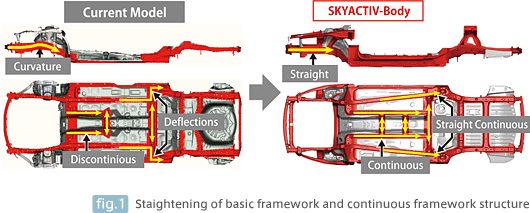Reconciling low and medium-speed agility with high-speed stability
The first challenge was to ensure high-speed stability from
a chassis that also delivered precise handling at low and mid-range speeds.
Mazda therefore developed a new electric power steering
system that enhances the driving experience by providing an immediate response
to the driver right from very low speeds. But such nimbleness could make the
vehicle react over-sensitively at higher speeds. This is where engineers
re-examined the rear suspension’s geometry. Suspension links were optimised and
rear-wheel grip enhanced to reduce yaw gain (or ease of turning). Meanwhile, a
higher steering gear ratio (for more direct steering) was adopted, increasing
yaw gain to maintain nimble steering at lower speeds. The vehicle is thus both
agile and stable, and the driver enjoys the best of both worlds at any given
speed.
The firm high-speed steering feel is reinforced by
increasing the caster angle — and therefore caster trail — on the front wheels
(see illustration), which enhances the steering’s self-aligning torque. Power
steering assistance is then increased at lower speeds to ease steering and give
it the desirably lighter feeling at such velocities. As a result, the new
generation of Mazda steers smoothly and securely in all situations.
Reconciling low and medium-speed agility with superior ride comfort
As the “interface” between the platform and the wheels, the
suspension is essential to a vehicle’s handling. The arrangement and structure
of the suspension determine the precision with which a car steers. They also
influence ride comfort. Therefore, the second great challenge for Mazda
developers was to optimise this architecture.
The rear suspension proved vital when trying to achieve the best possible balance between agility and ride comfort. The aim was to improve handling without stiffening springs or shock absorbers.
First of all, to enhance the operational efficiency of the dampers, the mounts were set at a position enabling a greater lever ratio. The damping force and rigidity of the top mount rubber were thus reinforced, reducing their impact on ride comfort. The rear suspension trailing link attachment position was also shifted upwards, thereby adjusting the direction of movement of the trailing links to more easily absorb longitudinal impact shocks from the road. This also improves ride comfort, while at the same time preventing the rear of the vehicle from rising. And that delivers increased stability when braking, which helps reduce stopping distance.
Reconciling reduced weight with increased rigidity
The chassis weighs 14% less than the current version. Yet it is still more rigid. And that was chassis breakthrough number three.
Engineers placed a special focus on the chassis cross members in their efforts to achieve the ambitious weight reduction objectives. After defining their functional requirements, CAE (computer-aided engineering) technology was used to design a conceptual model and coordinate the optimum structure into the overall vehicle package.
The centre section in the front of the car was extended and the longitudinal offset of the lower arm attachment position was reduced.
In the rear, meanwhile, the longitudinal span of the cross member was extended and the longitudinal offset of the lateral link attachment position reduced. Welding flanges were also removed from the front and the rear to enhance the coupling rigidity of the welded sections. All these measures considerably enhance overall stiffness in a lighter chassis.
This is how intelligent solution led to numerous improvements that together make up the SKYACTIV-Chasis. Engineeers have achieved what they set out to deliver. Namely, the driving fun, safety, ride cofort, agility and stability worthy of a new-generation Mazda















